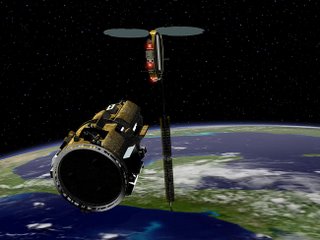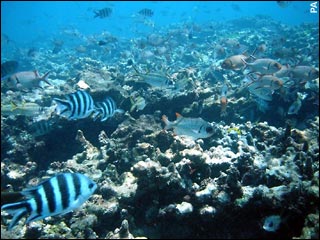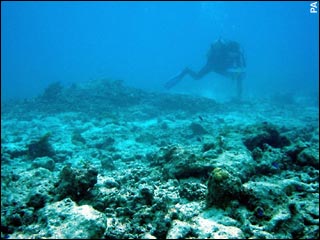
Part 1, How NASA Lost Its DART
NASA has losst onee of its satellites. The automated DART Satellite was supposed to rendezvous with a Pentagon satellite, but somehow it went awry.
The 800-pound (362-kilogram) DART spacecraft – short for Demonstration for Autonomous Rendezvous Technology – launched from California’s Vandenberg Air Force Base on April 15, 2005 atop an Orbital Sciences-built Pegasus XL rocket. The spacecraft was expected to rendezvous with MUBLCOM, or Multiple Path Beyond Line of Site Communication; a small communications satellite launched for the U.S. military in 1999.And that is that. not a good show.
DART’s $110-million mission called for the spacecraft to approach within 16 feet (five meters) of MUBLCOM and perform a series of intricate maneuvers near the older satellite, all without human intervention. The mission was to occur throughout a 24-hour period. But while DART ultimately found and approached the MUBLCOM satellite, it apparently closed to within 300 feet (91 meters) and ran out of fuel, bumping into the target spacecraft while both vehicles were 472 miles (760 kilometers) above Earth.
“Less than 11 hours into the mission, DART collided with MUBLCOM,” the investigation summary states. “MUBLCOM did not appear to experience significant damage, and the impact actually pushed it into a higher orbit.”
According to the mishap summary, DART’s velocity measurements by its primary global positioning system (GPS) receiver were off by about 1.9 feet per second (0.6 meters per second), an inaccuracy that persisted in the spacecraft despite a computer reset because the needed software patch was never installed. DART’s main computer repeatedly detected its velocity anomaly, reset itself, then again detected the same glitch, the summary stated.
An initial mismatch between expected and actual position appears to have started the continuous cycle – which forced the excessive thruster firings – but it was still not enough to lead DART into failure, according to the summary report. A computer logic setting that regulated how much weight the spacecraft gave its estimated and measured orbital speed and positions was set too high, allowing the initial glitch to continue, the summary stated.
Many of DART’s failings could have been avoided if the mission’s team members thoroughly reviewed and applied data and experience from previous NASA projects, investigators found.
Global Warming Is Killing Coral Seas
I know this is a bit 'I Told You So', but I told you so.

Earlier studies focused on coral damage but today's report is the first to show the long-term impact on fish and other creatures of the 1998 event where global warming caused Indian Ocean surface temperatures to increase to unprecedented and sustained levels, killing off (or "bleaching") more than 90 per cent of the inner Seychelles coral.Not a very pretty sight. Here's another entry from The Environmental News Service.
The team, led by the University of Newcastle upon Tyne, and which comprises researchers from Britain, Australia and the Seychelles, publishes its findings today in the Proceedings of the National Academy of Sciences.
The research in the inner islands of the Seychelles in 1994 and 2005 showed that, while the 1998 event was devastating in the short term, the main long-term impacts result when the damaged reefs were unable to re-seed and recover.
Many collapsed into rubble that became covered by algae. The collapse removed food and shelter from predators for a large, diverse amount of marine life. In 2005, average coral cover in the area was just 7.5 per cent.
Lead researcher Nick Graham, of Newcastle University's School of Marine Science and Technology, said, "We have shown there has been very little recovery in the reef system of the inner Seychelles islands for seven years after the 1998 coral bleaching event."If more people in power only knew how beautiful these things were, they'd probably campaign to make sure they didn't die out like this. It's a tragedy and a travesty.
While the 1998 event was devastating in the short term, the main long-term impacts are that the damaged reefs are largely unable to reseed and recover. "Many global warming bleaches simply collapsed into rubble which became covered by unsightly algae," Graham's team writes in their study, published Monday in the "Proceedings of the National Academy of Sciences," a U.S. publication.
"Reefs can sometimes recover after disturbances," said Graham, "but we have shown that after severe bleaching events, collapse in the physical structure of the reef results in profound impacts on other organisms in the ecosystem and greatly impedes the likelihood of recovery."
Bleaching occurs when corals encounter stressful environmental conditions, explain scientists at the Australian Institute of Marine Science in Townsville, a partner on the study team. High water temperature is the most prevalent stress leading to coral bleaching.
Stresses cause coral to expel zooxanthellae, the small algae living inside the bodies of coral. Because the zooanthellae give the coral their color, when they dissipate the corals suffer a loss of color, hampering the photosynthesis process. This eventually leads to death of the corals.
The collapse of the Seychelles reefs removed food and shelter from predators for a large number of diverse marine species. In their 2005 survey, the scientists found the average coral cover in the area to be just 7.5 percent.
The survey showed that four fish species are possibly already locally extinct - a type of butterfly fish, two types of wrasses and a type of damsel fish.
Six species are at critically low levels, the scientists found - a type of file fish, three types of butterfly fish and two damsel fish. Their decline probably started to happen soon after 1998, they said.
The survey also revealed that species diversity of the fish community had decreased by 50 percent in the heavily impacted sites. "Reduced biodiversity results in a more fragile and less stable ecosystem," the scientists wrote.
Smaller fish have been reduced in number more quickly than larger species but their decreased availability has started to have a more lasting effect on the food chain, the researchers found, and they projected that this effect is likely to be amplified as time goes on.
They observed a decrease in herbivorous fish, worrisome because these fish species control the spread of algae.


No comments:
Post a Comment